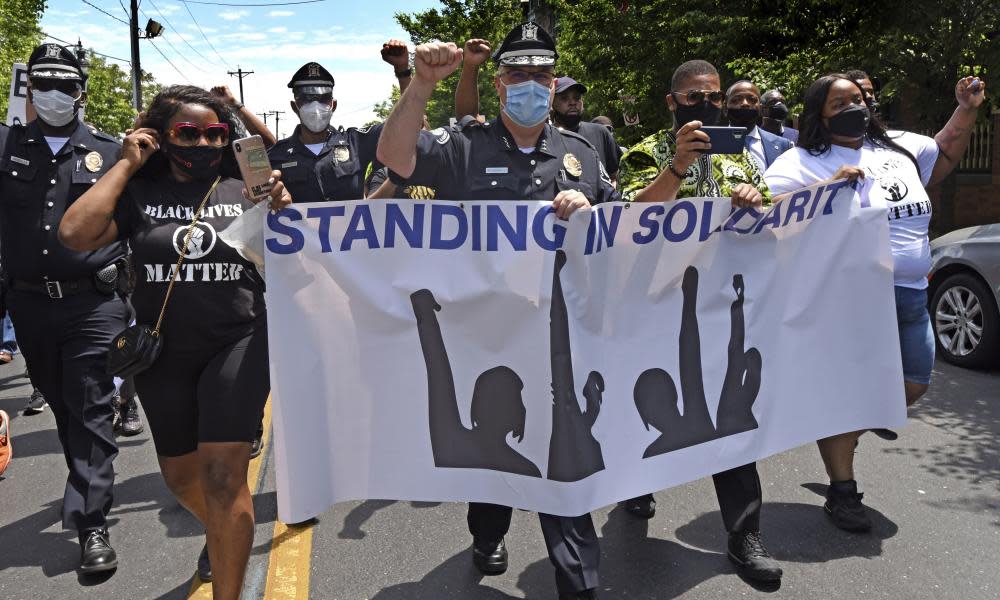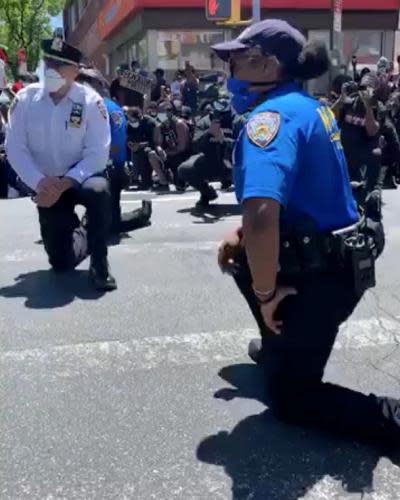Police marching with protesters: how some cities got it right and others didn't

When Larry Hamm, a veteran activist with People’s Organization for Progress, kicked off last weekend’s protest in Newark, New Jersey, he asked the crowd what they wanted. The majority – though not all – said they wanted a peaceful protest.
And so it was. Hamm, alongside Mayor Ras Baraka, and a few thousand people from the city and neighboring suburbs, marched through Newark. There were tense moments, and people throwing things at a police precinct, but – unlike many other protests across the US last weekend – there was no violence and no arrests.
“It’s not one thing that made [Saturday] turn out the way it did,” Hamm said. “It’s the history, it’s all the things that happened, here, the people, all of this work.”
As images of police ramming their cars into protesters and beating people with clubs were shared thousands of times this weekend, a few videos of law enforcement marching or kneeling with protesters also appeared.
These videos – some from majority black cities like Newark, New Jersey, and Flint, Michigan – were shared with messages about how police reform and police actions could de-escalate situations and lead to peaceful protests.
But the images were also loaded with much more complex histories through which last weekend was a peek into the window.
Newark residents like Hamm, for example, had been fighting this kind of violence for decades, including the 1967 riots, when thousands of residents took to the streets to protest about white police using excessive force and killing black civilians.
When he became mayor in 2014, Baraka made police reform a priority. He worked with activists lawmakers to form an independent citizen review board of police activities. Newark hired more local and minority police, and trained them to American Civil Liberties Union standards, which limit use of force. Baraka pushed back against the city’s powerful police union.
Last year, Newark’s crime rates dropped to an unprecedented low.
“This relationship has been a nurtured one,” Baraka said of bridging the communication gap between police and the Newark community, and that paid off last weekend when the tense protest ended without any arrests. “The police showed an uncanny level of restraint. They did not come downtown with tanks and body armor.”

Nor was Newark unique.
Less than a hundred miles away in Camden, New Jersey, the police chief, Joe Wysocki, and a handful of other police officers marched with protesters in the county they serve after activist Yolanda Deaver invited them.
“At one point Yolanda was shouting Black Lives Matter, and she kind of looked at me, and I said: ‘It’s OK, that’s why we’re here,” Wysocki said.
Camden, touted by former president Barack Obama as a model for police reform, has also seen sweeping changes to its police force in the past decade. The county has introduced some of the strictest policies in the country regarding how police use force – strangling and suffocating, the way that police killed George Floyd in Minneapolis, are not tolerated.
In Camden, police officers train in simulators that include racial bias testing, and commanders watch body-camera footage regularly and analyze officer behavior. Last year, the Minneapolis commissioner, John Harrington, who oversees community policing, even consulted with the Camden police to learn their protocols.
But truly reforming the police often takes more than training, said Sam Sinyangwe, a data scientist and activist who co-founded Campaign Zero, a platform which tracks the impact of police violence and possible solutions. “Even if you have a police chief or mayor who cares, they don’t always have the power to hold the officers accountable,” he said.
There are a few policies that Sinyangwe said the evidence supports. There is not enough data, Sinyangwe said, to say that anti-bias training and classes are a solution. Instead, he points to strong restrictions on how police can use force, curbing the military-grade weapons distributed to the police and cracking down on police union contracts.
There is also an increasingly important conversation about defunding the police, which lawmakers such as Alexandra Ocasio-Cortez have resurfaced this week. The $6bn New York police department, for example, is bigger than the city’s budget for many housing, education and health initiatives.

“Part of police violence is policing of things that shouldn’t be policed,” Sinyangwe said, such as sending police to people having mental health crises. “To do that we have to make a divestment from policing and shift those resources.”
Without a cocktail of comprehensive policies and accountability, some of the police efforts to express solidarity have been less effective. When New York police kneeled at a protest on Sunday, some pointed out that they went on to use brutal force against residents an hour later.
In Flint, Michigan, Sheriff Chris Swanson joined the protest last weekend, saying he wanted it to be a “parade not a protest”. The video went viral, and residents were relieved that nobody in the city, which is still dealing with a water and economic crisis, got hurt. But some said that the message felt like it only took away from the focus of the protest on George Floyd, especially since the community’s relationship with the police was not strong.
“A lot of people know that Flint has an understaffed police force. They’re not really present,” said Anthony Fisher, a 21-year-old student and native of the city. “It’s a good gesture, but some people get carried away.”
For Hamm, in Newark, it was clear the uprising and unrest happening across the country is a culmination of years of police brutality against black communities. He said his group, which has held weekly protests on the issue for years, and its relationship with city leaders and clergy, set the stage for a demonstration that represented Newark.
“When we marched there was already a kind of set of conditions in existence that would help prevent some sort of disturbance,” he said. “This is the power of George Floyd. The way he died has had a tremendous impact on people’s consciousness.”


